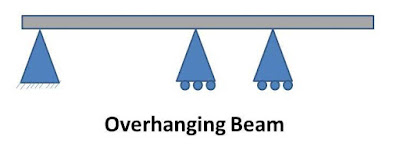Today we
will discuss about what is beam and types of beams. Beam is a
horizontal structure
member used to carry vertical load, shear load and sometime horizontal
load. It is the major component of building structures. It
mainly use in construction of bridges, trusses, and other structures
which carry
vertical load. Beams may be define as:
Any structure member which cross section is much smaller compare
to its length and undergoes lateral load, known as beam.
In other words beam is a horizontal bar witch undergoes lateral
load or couple which tends to bend it or a horizontal bar undergoes bending
stress known as beam.
According to its requirement, different beams use in different
conditions like fix beam, cantilever beam etc.
Types of beams:
Beams are classified as follow.
According to end support:
1. Simply Supported Beam:
As the name implies, simply supported beam is supported at both
end. One end of the beam is supported by hinge support and other one by roller
support. This support allow to horizontal movement of beam. It beam type undergoes
both shear stress and bending moment.
2. Continuous Beams:
When we talk about types of beams we cannot forgot continuous beam. This beam is similar to simply supported beam except more
than two support are used on it. One end of it is supported by hinged support
and other one is roller support. One or more supports are use between these
beams. It is used in long concrete bridges where length of bridge is too large.
3. Overhanging Beams:
Overhanging
beam is combination of simply supported beam and cantilever beam. One
or both of end overhang of this beam. This beam is
supported by roller support between two ends. This type of beam has
heritage properties of cantilever
and simply supported beam.
4. Cantilever Beams:
Cantilever beams a structure member of which one end is
fixed and other is free. This is one of the famous type of beam use in trusses,
bridges and other structure member. This beam carry load over the span which
undergoes both shear stress and bending moment.
5. Fixed beams:
This beam is fixed from both ends. It does
not allow vertical movement and rotation of the beam. It is only under shear stress
and no moment produces in this beams. It is used in trusses, and other structure.
According to cross section:
A beam may have different cross section. The most common
cross section of beam are as follow.
1. I beam:
This beam types have I cross section as shown in figure. It has high resistance of bending.
2. T beam:
It has T cross section as shown in figure.
According to equilibrium condition:
1. Statically determinate beam:
A beam is called determinate beam if it can be analyze by
the basic equilibrium condition. The support reaction can be found by using basic
equilibrium condition. These conditions are
Summation of all horizontal forces is zero.
Summation of all vertical forces is zero.
Summation of all moments is zero.
Example: Simply supported beam, Cantilever beam etc.
2. Statically indeterminate beam:
If the beam cannot be analysis by using basic equilibrium condition,
known as statically indeterminate beam. The end reaction find out by using
basic equilibrium condition with combination of other conditions like strain
energy method, virtual work method etc.
Example: Continuous beam, fixed beam
According to Geometry:
1. Straight beam
2. Curved beam
3. Tapper beam
Today we
have discussed article What is Beam and types of beams. If you have any
query regarding this article ask by commenting below.
TYPES OF SUPPORTSRoller Supports |
|
Hinge Supports
The hinge support is capable of
resisting forces acting in any direction of the plane. This support
does not provide any resistance to rotation. The horizontal and
vertical component of reaction can be determined using equation of
equilibrium. Hinge support may also be used in three hinged arched
bridges at the banks supports while at the center internal hinge is
introduced. It is also used in doors to produce only rotation in a
door. Hinge support reduces sensitivity to earthquake.
FIXED SUPPORT
Fixed support can resist vertical and horizontal forces as well as
moment since they restrain both rotation and translation. They are also
known as rigid support For the stability of a structure there should be
one fixed support. A flagpole at concrete base is common example of
fixed support In RCC structures the steel reinforcement of a beam is
embedded in a column to produce a fixed support as shown in above
image. Similarly all the riveted and welded joints in steel structure
are the examples of fixed supports Riveted connection are not very much
common now a days due to the introduction of bolted joints.
PINNED SUPPORTSINTERNAL HINGEInterior hinges are often used to join flexural members at points other than supports. For example in above fig two halves of an arch is joined with the help of internal hinge.
In some cases it is intentionally introduced so that excess load
breaks this weak zone rather than damaging other structural elements as
shown in above image.
| |









No comments:
Post a Comment